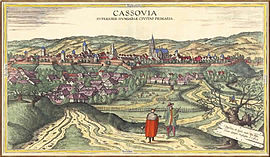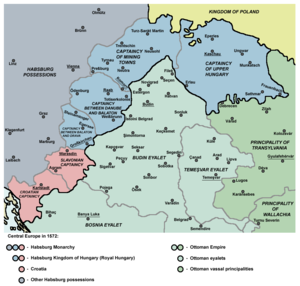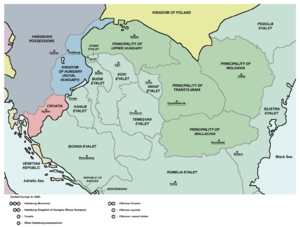- Upper Hungary
-
 "Cassovia: Superioris Hungariae Civitas Primaria",[1] the prospect from Civitates orbis terrarum. Cassovia (Slovak: Košice, German: Kaschau, Hungarian: Kassa), the "capital" of Upper Hungary in 1617.
"Cassovia: Superioris Hungariae Civitas Primaria",[1] the prospect from Civitates orbis terrarum. Cassovia (Slovak: Košice, German: Kaschau, Hungarian: Kassa), the "capital" of Upper Hungary in 1617.
Upper Hungary (Hungarian: Felső-Magyarország or Felvidék, Slovak: Horné Uhorsko) is the usual English translation for the area that was historically the northern part of the Kingdom of Hungary, now mostly present-day Slovakia.[2][3][4][5] Slovaks called this territory Slovensko (Slovakia) - the term appears in written documents from as early as fifteenth century, but it was not precisely defined, and this region was called Upper Hungary in Hungarian literature.[6] However, the region inhabited by Slovaks held no distinct legal, constitutional, or political status within the Kingdom of Hungary.[7]
Contents
Etymology
Historical usage
Historically there are different meanings:
1. The older Hungarian term Felső-Magyarország (literally: "Upper Hungary"; Slovak: Horné Uhorsko; German: Oberungarn) formally referred to what is today Slovakia in the 16th-18th centuries and informally to all the northern parts of the Kingdom of Hungary in the 19th century.
2. The Hungarian Felvidék (literally: "Upper Country", "Upland", "Highland"; Slovak: Horná zem; German: Oberland; Yiddish: אױבערלאַנד) has had several informal meanings:
- In the 19th century and part of the 18th, it was usually used:
- to denote the mountainous northern part of the Kingdom of Hungary as opposed to the southern lowlands
- more generally, to denote regions or territories situated at a higher altitude than the settlement of the speaker
- as a synonym for the then-meaning of Felső-Magyarország
- After World War I, the meaning in the Hungarian language was restricted to Slovakia and Carpathian Ruthenia, and after World War II to Slovakia only. At the same time, the word felvidék remains a common Hungarian noun applied to areas at higher elevations, e.g., Balaton-felvidék,[8] a hilly region and national park[9] adjacent to Lake Balaton.
Modern usage
After World War I, the meaning of Felvidék in the Hungarian language (Felső-Magyarország was not used anymore) was restricted to Slovakia and Carpathian Ruthenia. Today the term Felvidék is sometimes used in Hungary when speaking about Slovakia, and it is exclusively (and anachronistically) used in Hungarian historical literature when speaking about the Middle Ages, i.e., before the name actually came into existence. The three counties of the region that remained in Hungary after World War I, however, are never called Upper Hungary today, only Northern Hungary (Észak-Magyarország). Any use of the word Felvidék to denote all of modern Slovakia is considered offensive by Slovaks,[10] and inappropriate by some Hungarians,[11] but it is now commonly used by the sizeable Hungarian minority in the southern border-zone of Slovakia[12] to identify the Hungarian-majority areas where they live.[13] Some of them call themselves felvidéki magyarok, i.e. the "Upland Magyars." The word felvidék also functions as an ordinary noun used to denote areas at higher elevations in present-day Hungary.[14]
History of Upper Hungary
Middle Ages
The term Upper Hungary often occurs in publications on history as a somewhat anachronistic translation of other, earlier (at that time Latin) designations denoting approximately the same territory. These other terms were, for example, Partes Danubii septentrionales (Territories to the north of the Danube) or Partes regni superiores (Upper parts of the Kingdom). The actual name "Upper Hungary" arose later from the latter phrase. In the 15th century, the "Somorja, Nagyszombat, Galgóc, Nyitra, Léva, Losonc, Rimaszombat, Rozsnyó, Jászó, Kassa, Gálszécs, Nagymihály" line was the northern "boundary" of the Hungarian ethnic area.[15]
Affiliation to Hungary
The Principality of Nitra emerged in the 8th century and developed into an independent Slavic state; although the polity may have lost its independence when it was still at the stage of development.[16][17] In the early 9th century, the polity was situated on the north-western territories of present-day Slovakia.[18]
Toponyms may prove that the nomadic Magyars occupied the Western Pannonian Plain in the Upper Hungary, while the hills were inhabited by a mixed (Slav and Hungarian) population and people living in the valleys of the mountains spoke Slavic language.[19]
16th - 18th centuries
The term emerged approximately after the conquest of today's Hungary by the Ottomans in the 16th century when Felső-Magyarország (German: Oberungarn; Slovak: Horné Uhorsko) referred to present-day whole Slovakia and the adjacent territories of today's Hungary and Ukraine that were not occupied by the Ottoman Empire. That territory formed a separate military district (the "Captaincy of Upper Hungary" (1564–1686) headquartered in Kaschau/Kassa/Košice) within Royal Hungary. At that time, present-day western Slovakia, and sometimes also the remaining territories of Royal Hungary to the south of it, were called Lower Hungary (Hungarian: Alsó-Magyarország; German: Niederungarn; Slovak: Dolné Uhorsko).
It was briefly a separate vassal state of the Ottoman Empire under Imre Thököly in the 1680s.
This usage occurs in many texts up to around 1800 – for example, the renowned mining school of Schemnitz/Selmecbánya/Banská Štiavnica in present-day central Slovakia was founded in "Lower" Hungary (not in "Upper" Hungary) in the 18th century and Pozsony (today Bratislava) was also referred to as being in "Lower" Hungary in the late 18th century.
17th century - early 20th century
From the end of the 17th century (in many texts however only after around 1800) until 1918, the territory of the Kingdom of Hungary north of the Tisza and the Danube, which comprised present-day Slovakia, Carpathian Ruthenia, and approximately the Hungarian counties of Nógrád, Heves, and Borsod-Abaúj-Zemplén, was informally called either "Upper Hungary" or "Upland" (Felső-Magyarország or Felvidék). Although not strictly defined, the name Felvidék became commonplace to the point that at least one publication concerning the area used it as its title.[20] Other nations used the terms "Upper Hungary" (for the northern part of the Kingdom), "Slovakia" (only for the territory predominantly inhabited by the Slovaks), and "Ruthenia" (the territory predominantly inhabited by the Ruthenians) in parallel. The Slovaks themselves called the territories of the Kingdom of Hungary to the south of Slovakia Dolná zem ("Lower Land").
In the course of the creation of Czechoslovakia at the end of World War I, Czechoslovakia originally demanded that all of the so-called Upper Hungary be added to Czechoslovak territory (i.e. including the territory between the Tisza River and present-day Slovakia). The claim for its acquisition, however, was not based on the whole area having a single common name, "Upper Hungary", but on the presence of a Slovak minority in the region.
Population in the 18th century
In 1720 of the 63 largest town on the territory of present-day Slovakia with at least 100 taxpaying households 40 had Slovak majority, 14 German and 9 Hungarian majority.[15]
Population in the 19th century
The first ethnic data of whole Hungarian Kingdom by county was published in 1842. According to this survey the total population of the counties in Upper Hungary exceeded 2.4 million, with the following ethnic distribution: 59.5 % Slovaks, 22 % Magyars, 8.3 % Ruthenians, 6.7 % Germans and 3.6 % Jews.[15]
See also
References
- ^ Matica slovenská, Kniha, Matica slovenská, 2008, p. 16
- ^ Duncan Gardiner, PhD. German Towns in Slovakia and Upper Hungary: A Genealogical Gazetteer. 1991. ISBN 978-0929871028
- ^ Tilman Berger, Slovaks in Czechia Czechs in Slovakia, International Journal of the Sociology of Language. Volume 2003, Issue 162, Pages 19–39, ISSN 1613-3668
- ^ Eric Hirsch, Voices from the Black Box: Folk Song, Boy Scouts and the Construction of Folk Nationalist Hegemony in Hungary, 1930–1944, 2009, DOI: 10.1111/1467-8330.00043
- ^ Philip D. Jones, History and climate: memories of the future?, page 234
- ^ Dusan Kovac. 2011. p. 3. [1]
- ^ James Ramon Felak (15 June 1995). At the Price of the Republic: Hlinka's Slovak People's Party, 1929-1938. University of Pittsburgh Pre. pp. 3–. ISBN 978-0-8229-8552-5. http://books.google.com/books?id=sOlD_8Kw0K0C&pg=PA3. Retrieved 20 September 2011.
- ^ Balaton-felvidéki Nemzeti Park
- ^ Balaton Uplands National Park
- ^ E.g., Peter Morvay, "Orbán rečnil, Duray len počúval." Sme, 3 April 2006.
- ^ István Käfer, "Terminologia Hungaro-Sclavonica: a magyar-szlovák interetnikus összefüggések történeti vizsgálatának terminológiai kérdései." in: Marianne Rozsondai, ed. Jubileumi csokor Csapodi Csaba tiszteletére. Tanulmányok. Budapest: Argumentum, 2002.
- ^ István Lanstyák and Simon Szabolcs, eds. Tanulmányok a magyar–szlovák kétnyelvűségről. Bratislava: Kalligram, 1998.
- ^ See, e.g., the systematic differentiated use of the words Felvidék and Szlovákia in the Hungarian-language newspaper Új Szó published by the Hungarians in Slovakia.
- ^ Tamás Budai, et al., A Balaton-felvidék földtana/Geology of the Balaton-highland/ ("Magyarázó a Balaton-felvidék földtani térképéhez"/Explanation supplement for the geology map of the Balaton-highland/, 1:50 000). Budapest: MÁFI kiadása, 1999.
- ^ a b c Károly Kocsis, Eszter Kocsisné Hodosi, Ethnic Geography of the Hungarian Minorities in the Carpathian Basin, Simon Publications LLC, 1998, pp. 42-47-52
- ^ "Nitra: from fields to factories". The Slovak Spectator. 2004-07-12. http://www.spectator.sk/articles/view/16658. Retrieved 2008-04-22.
- ^ Poulik, Josef (1978). The Origins of Christianity in Slavonic Countries North of the Middle Danube Basin. Taylor&Francis Ltd.. JSTOR 124226.
- ^ . p. 37.
- ^ Kniezsa, István (2000). Magyarország népei a XI. században. Lucidus Kiadó. p. 26. ISBN 963 85954 3 4.
- ^ Béla Grünwald, A Felvidék; politikai tanulmány. Budapest: Kiadja Ráth Mór, 1878.
Categories:- Historical regions in Slovakia
- Historical regions in Hungary
- History of Slovakia
- History of Hungary
- Kingdom of Hungary
- In the 19th century and part of the 18th, it was usually used:
Wikimedia Foundation. 2010.


